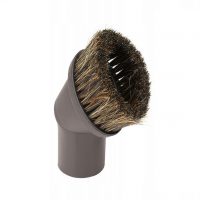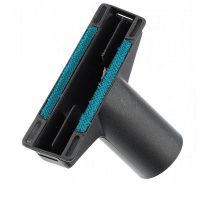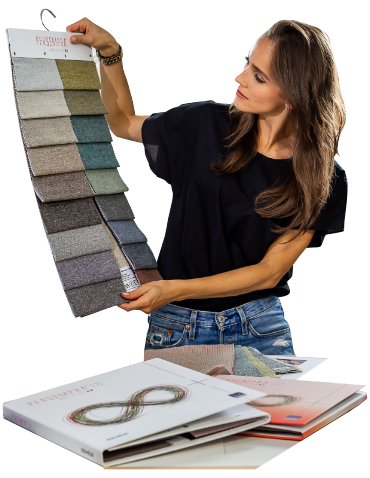Jak czyścić tkaniny obiciowe?

Tak jak wszystkie inne codziennie używane tkaniny, również tkaniny tapicerskie ulegają stałym zabrudzeniom oraz zakurzeniu. Dlatego by utrzymać tkaninę w najlepszym stanie, konieczne jest jej cotygodniowe odkurzanie i pielęgnacja – to warunek konieczny, zapoznaj się więc ze wskazówkami dotyczącymi CZYSZCZENIA.
Natomiast NANO STOP SYSTEM pomoże Ci w przypadkach niespodziewanych zabrudzeń i plam powstałych przez przypadek – instrukcja USUWANIA PLAM i PORADKIKI WIDEO pomogą Ci poradzić sobie szybko nawet z w bardzo trudnych przypadkach.
Czyszczenie tkanin obiciowych
Pamiętaj, że podobnie jak inne tkaniny, również tkaniny tapicerskie ulegają stałym zabrudzeniom oraz zakurzeniu. Aby utrzymać tkaninę w jak najlepszym stanie, konieczne jest jej systematyczne czyszczenie oraz przestrzeganie innych zasad dotyczących pielęgnacji tkanin.
Zalecenia:
- Odkurzaj regularnie tapicerkę wyłącznie przy użyciu końcówki odkurzacza przeznaczonej do mebli.
- Odkurzaj na niskim poziomie mocy, ze zwróceniem szczególnej uwagi na wykończenia i krawędzie.
Zakazy:
- Nie pocieraj gwałtownie tkaniny.
- Nie używaj ostrych gąbek lub ściereczek oraz końcówek odkurzacza nieprzeznaczonych do mebli
- Nie odkurzaj odkurzaczem nastawionym na najwyższy poziom mocy.


Zalecenia:
- Pierz pokrycie na lewej stronie z zapiętym zamkiem błyskawicznym. Jeśli zamiast zamka zastosowano nylonowe zapięcia, zabezpiecz je, dołączając kawałek materiału.
- Używaj neutralnych środków czyszczących.
- Pierz w zalecanej temperaturze wskazanej w informacji o produkcie. Zawsze stosuj program prania delikatnego.
- Wiruj tkaninę na niskich obrotach.
Zakazy:
- Nie używaj wybielaczy lub środków żrących.
- Nie stosuj środków zmiękczających.
- Nie pierz z innymi materiałami.
- Nie pierz tapicerki, gdy pokrycie wykonane jest z dwóch lub większej liczby różnych rodzajów tkaniny.
Zalecenia:
- Rozciągnij pokrycie w obie strony, gdy jest jeszcze wilgotne.
- Susz w temperaturze otoczenia.
Zakazy:
- Jeżeli nie jest to konieczne. nie używaj suszarki zwłaszcza z bliskiej odległości.
- Nie wystawiaj tkaniny bezpośrednio na światło słoneczne.
Zalecenia:
- Przed prasowaniem sprawdź czy tkaninę można prasować.
- Prasuj tkaninę przykrytą białą ściereczką w temperaturze zalecanej w informacji o produkcie.
Zakazy:
- Nie prasuj tkaniny w temperaturze innej niż wskazana.
- Nie prasuj tkaniny bezpośrednio.
Zalecenia:
- Użytkuj mebel zgodnie z jego przeznaczeniem.
Zakazy:
- Nie używaj mebla w sposób niewłaściwy lub wywołujący odkształcenia. Nie stawaj na siedzisku. Nie siadaj na podparciach.
- Nie wystawiaj mebla bezpośrednio na światło słoneczne lub silne światło sztuczne.
- Nie umieszczaj mebla w odległości bliższej niż 50 cm od jakiegokolwiek źródła ciepła.
Tkaniny obiciowe łatwe do czyszczenia
Usuwanie plam i zabrudzeńZasady usuwania przypadkowo powstałych plam i zabrudzeń, w zależności od ich rodzaju.
Pamiętaj, aby przed przystąpieniem do usuwania plam ustalić, jaki rodzaj substancji ją spowodował oraz sprawdzić, skład tkaniny z której wykonana jest tapicerka. Pozwoli to zastosować środki, które usuną plamę, ale nie zniszczą tkaniny.
Przed czyszczeniem sprawdź trwałość barwników wykorzystanych w tkaninie, na niewielkiej niewidocznej powierzchni.
Usuwanie plam przeprowadź możliwie szybko po zauważeniu zaplamienia. Świeża plama usuwa się bowiem o wiele łatwiej niż dawna, ponieważ substancja powodująca zaplamienie nie zdąży przeniknąć w głąb włókien, z których zbudowany jest materiał.
Od razu zgarnij substancję plamiącą przy użyciu chłonącej ściereczki. Rób to delikatnymi ruchami kolistymi w kierunku środka plamy. Nie wcieraj! Nie rozciągaj i nie szarp tkaniny!
UWAGA!
- Mocne kwasy niszczą tkaniny, zwłaszcza te z włóknami roślinnymi (bawełna).
- Gorąca woda i żrące mydła niszczą materiały z włókien syntetycznych.
W wypadku plam tłustych lub mokrych użyj najpierw bibuły, a następnie czystej, wilgotnej i delikatnej gąbki, by szybko wchłonąć plamę. Następnie czyść letnią wodą i neutralnym środkiem czyszczącym do prania ręcznego. Wypłucz środek czystą wodą. Wytrzyj ściereczką i pozostaw do osuszenia w temperaturze pokojowej.
W wypadku zaschniętych plam usuń tępym narzędziem np. łyżką nadmiar substancji brudzącej, a następnie postępuj zgodnie ze wskazówkami zawartymi w poprzednim akapicie.
Nie zalewaj tkaniny wodą czy wodą z detergentem.
Nigdy nie siadaj na tapicerowanym meblu dopóki pokrycie nie jest zupełnie suche.
Po wysuszeniu wyczyść mebel na najniższej mocy odkurzacza przy użyciu końcówki do czyszczenia mebli.
Do czyszczenia plam używaj rozpuszczalników, wybielaczy lub odplamiaczy w małych ilościach. W przypadku profesjonalnych środków postępuj zawsze zgodnie z instrukcją. Działanie środków sprawdź przed użyciem na niewidocznej części mebla.
Przeczytaj informacje na pojemniku ze środkiem i stosuj się do zaleceń bezpieczeństwa. Czyść zawsze przy otwartym oknie i daleko od ognia.
Nie mieszaj chemikaliów. Gdy tkanina była już czyszczona jednym środkiem chemicznym, najpierw dokładnie ją wysusz, wypłucz i dopiero wówczas czyść innym środkiem.
Używając rozpuszczalnika nie nakładaj go bezpośrednio na plamę, użyj czystej ściereczki.
Po działaniu rozpuszczalnikami ważne jest ich dokładne usunięcie wraz z zanieczyszczeniami, w przeciwnym wypadku naokoło miejsca odplamionego tworzy się zaciek, czyli tzw. otoczka. Aby tego uniknąć, połóż pod zaplamiony materiał gruby podkład z białej tkaniny bawełnianej lub lnianej. Następnie tamponem z gazy lekarskiej, zamoczonym w rozpuszczalniku, uderzaj, przyciskaj zaplamione miejsca. Nie pocieraj! Po kilku ruchach tampon wymień na czysty. Często wymieniaj także podkłady. Powstawaniu otoczki zapobiega również zwilżanie materiału naokoło plamy wodą.
Jeśli odplamiasz substancjami wywołującymi reakcje chemiczne na materiale, to po usunięciu plamy, usuń starannie środek wywabiający (przez płukanie w wodzie lub zobojętnienie odpowiednimi odczynnikami). W przeciwnym razie materiał ulegnie uszkodzeniu natychmiast lub po pewnym czasie.
Używając odplamiacza, usuń wszelkie pozostałości czystą ściereczką i miękką szczotką, zawsze szczotkując z włosem.
















